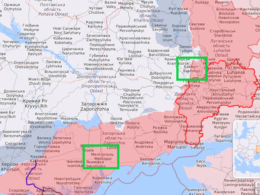Russian forces will likely be able to stretch Ukrainian forces across a wide frontline area and pin down Ukrainian troops along the international border, even as their offensive operations slow in northern Kharkiv Oblast, according to an assessment by the Institute for the Study of War (ISW).
The ISW analysts cited a statement by the Commander-in-Chief of the Ukrainian Armed Forces, Oleksandr Syrskyi, saying Russian forces have expanded the active combat zone by about 70 km since beginning their northern Kharkiv offensive. Russia is trying to force Ukraine to commit reserve brigades to the front lines.
The report states, "Russian offensives along the Kharkiv international border likely aim to draw and fix Ukrainian forces to this axis, enabling Russian advances in other areas of eastern Ukraine."
Additionally, even limited Russian activity near the border short of full offensive operations could stretch Ukrainian forces thinner across a wider frontline.
Russian forces have a pattern of conducting "pulsed" offensives across different front sectors, decreasing intensity in one area while increasing it in another. So they may temporarily slow operations in northern Kharkiv before resuming that offensive later.
On 10 May, Russian troops began their northern Kharkiv offensive. Ukrainian President Volodymyr Zelenskyy said they advanced 10 km before Ukrainian forces "stabilized the situation."
Vladimir Putin claimed Russia does not currently plan to capture Kharkiv city itself. He stated the goal is creating a buffer zone to secure Russia's Belgorod Oblast from Ukrainian shelling.
Read more:
- Updated: Russian attacks on Kharkiv and Odesa kill four, injure 36
- UK intel: No shift on war in Ukraine expected after Russia replaced Shoigu with Belousov as defense minister
- Ukraine attacks Russia's oil facilities at eastern Black Sea coast
- Frontline report: Ukraine seizes initiative after wildfires ravage Russian positions in Luhansk Oblast




